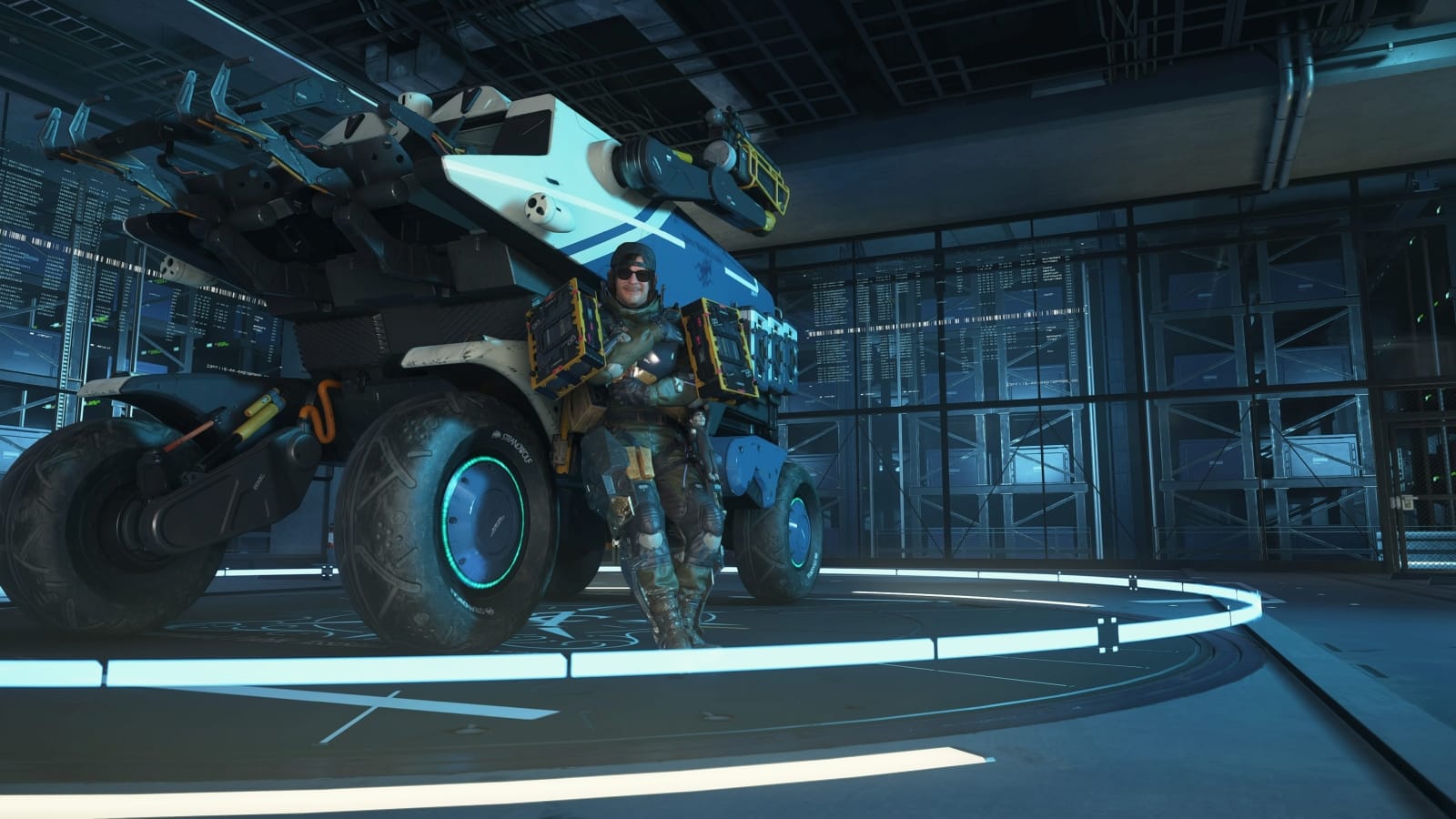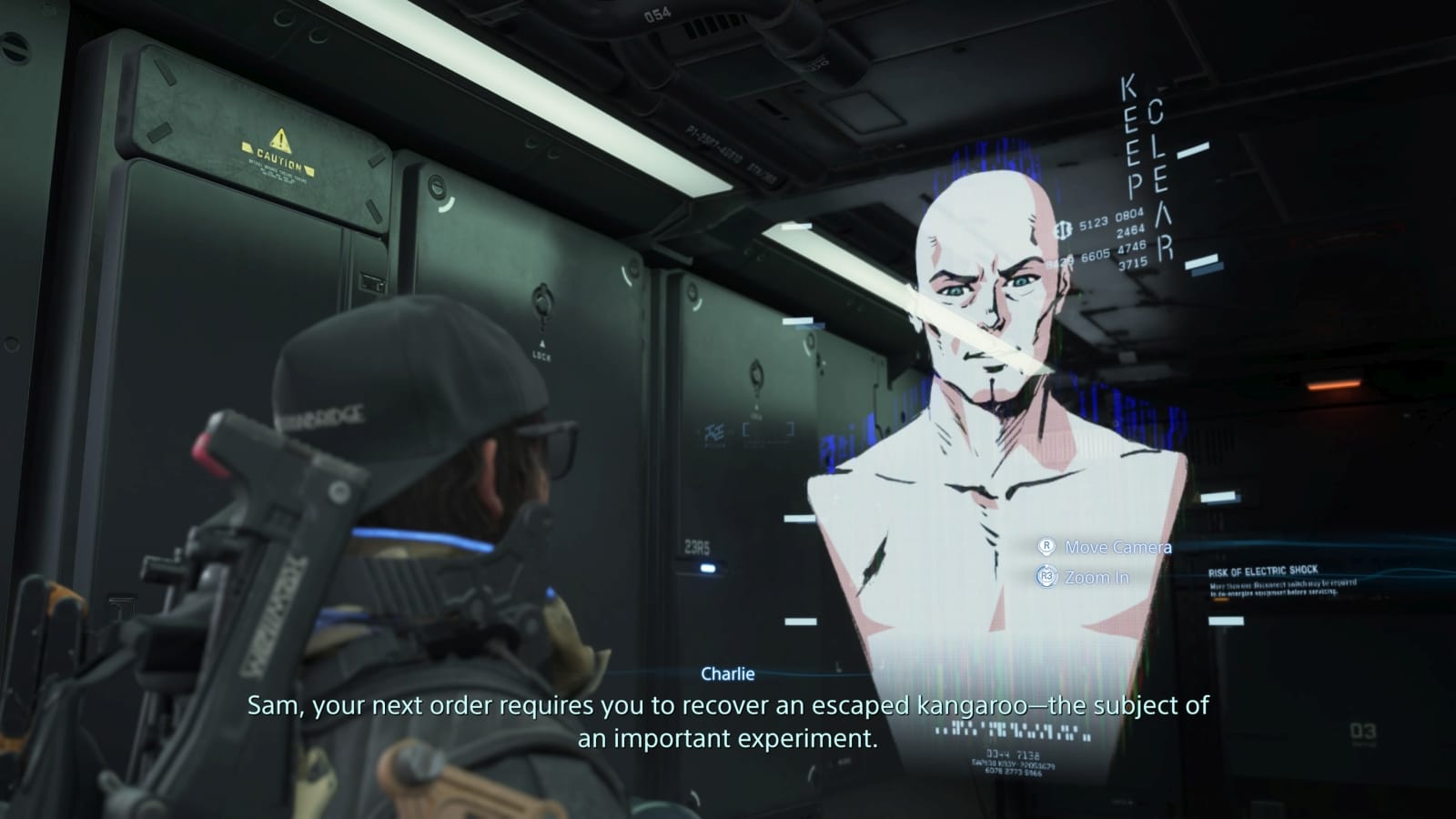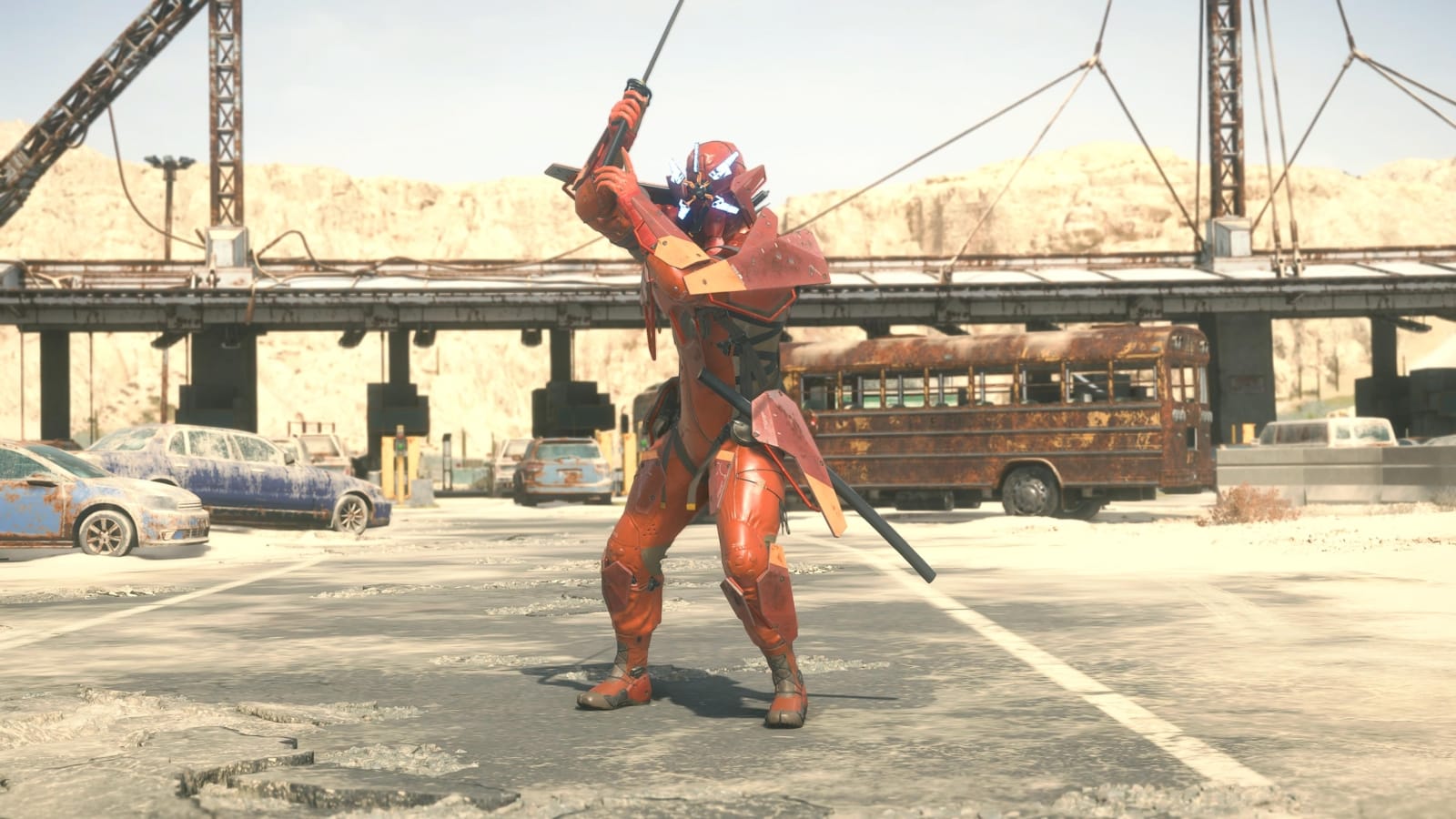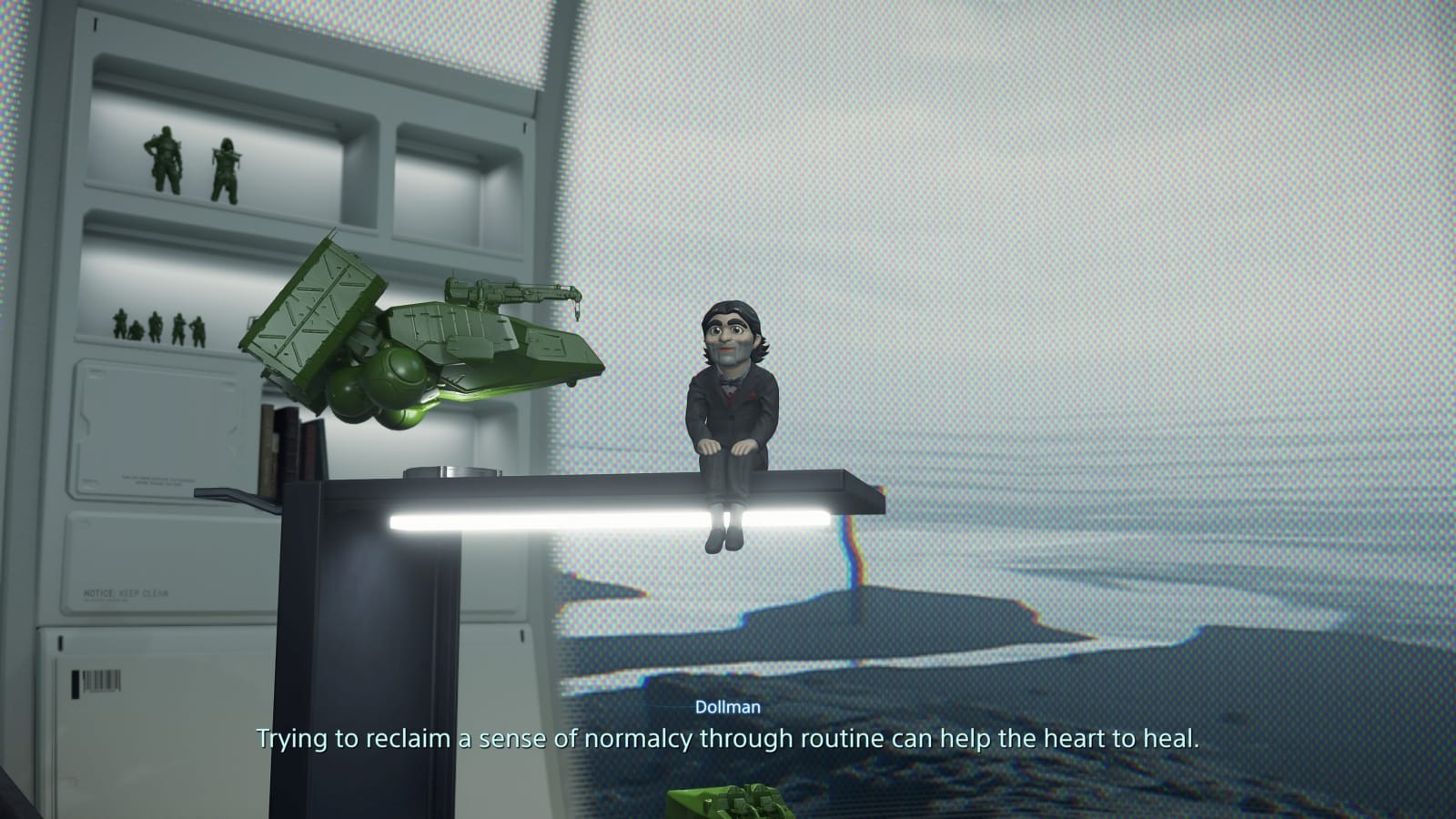
The Death Stranding caused more than just one rift across the Earth. In connecting the worlds of the living and the dead, connections between people were severed. Timefall made it too dangerous for people to leave their homes or live outside of specialized cities dotted across the landscape. Bonds between nations, too, were cut, with no means of travel across the Atlantic or Pacific Oceans. Slowly, the United States came back together through the efforts of one man and his Bridge Baby: Sam Porter Bridges. After linking the United Cities of America to the Chiral Network, he vanished, along with his BB. Now, eleven months later, he’s living happily on the Mexican border and raising Lou, having long outgrown the BB pod. Fragile, now part of a civilian organization called Drawbridge, finds Sam and asks him to go back out there and connect more people, first Mexico then Australia by way of the newly appeared Plate Gate that facilitates instantaneous travel between the two continents. Over the course of the journey, Sam’s connections will be tested, some even broken, but one thing will always remain true: death can’t tear us apart.
2019’s Death Stranding remains one of my favorite gaming experiences ever. It was a game that had both a massive budget and very clear artistic intent, feeling like every person who worked on it put their whole selves into the title. It was also a very weird game, quite literally being something of a walking simulator where you watch lengthy cutscenes between legs of your journey across North America. In other words, it’s my kind of game. I loved navigating precarious terrain while carrying fragile packages between preppers and avoiding ghostly apparitions who could easily kill me. You know, just mailman things.
Death Stranding 2: On the Beach builds on the foundations the original game set, and in a lot of ways it feels like a massive expansion on that title rather than an entirely new game. You start off with just the basics, but you’re quickly given all of your tools from the first game so this sequel can start introducing its own things. It’s very streamlined, making every task faster and more convenient with reworked menus and tighter controls. However it does feel like, in making the experience smoother, some of what made it so interesting and fun has been shaved off. For example, BTs are pretty rare to come across and you can actually see them now rather than having to rely on your Odradek for clues on where or how close they are. They’re such a non-issue I just drove past them most of the time. You gain access to vehicles very early on in the game, but before then I stole an armed survivalist’s truck and used that to make deliveries until I unlocked the ability to make my own trucks. After 4 or 5 hours of playing the game, I never really had to walk anywhere again.
A lot of that is due to Australia's terrain. There aren’t any big cliffs or crevasses that you can’t easily drive off or around. When I needed to traverse the big mountain at the center of the continent, I assumed this was going to be the real test of my on-foot traversal, but surprisingly a few missions later I discovered I could still very easily just drive everywhere. Walking is actually detrimental to you, as a covered Pick-Up Off-Roader will protect your cargo from Timefall damage and allow you to pick up lost cargo just by driving near it with the right attachments. Even playing on Brutal, the hardest difficulty, I was constantly getting S ranks for just about every delivery.

Even with that in mind, I still loved playing Death Stranding 2. There’s still nothing quite like these games out there, especially with all the structures, signs, and requests that appear once you connect an area to the Chiral Network. Setting up a charging station, watchtower, or bridge knowing other players will make use of them just feels good, as does using those things other people have built themselves. Even after the servers went down about 10 hours before I finished the game, I still felt some connection to all those strangers who helped me get this far in the first place. The game became a bit more difficult when their creations stopped appearing in my game, but I still found myself setting things up for when the servers go live again, as anything you build or change in the world will affect other players' games. Adding materials to roads that I wouldn’t really benefit from, placing signs to warn people about difficult terrain or BTs, or fulfilling the odd request for weapons or gear; just to make the journey of those who come after that a little bit easier. Even with the world so incredibly bleak right now, Death Stranding 2 gives you that little bit of hope for humanity.
Connection is really what Death Stranding is about. The first game was all about finding connections in a world that wanted you to remain alone. It was shown directly through Sam’s quiet demeanor and aphenphosmphobia, or fear of being touched. On the Beach asks ‘should we have connected?’ The connections we form, whether good or bad, will inevitably hurt everyone involved through betrayal, simple disagreements, or death. Is connecting with other people worth it, despite the pain they will bring? You can probably guess the game answers in the affirmative, but it still has a lot to say about that theme, especially about how those connections remain even if they appear to be severed.

It’s far from a universal experience, but I certainly felt that theme in the servers being shut down before the game’s launch. If you play Death Stranding 2 and connect to the internet at any point, you will leave some sort of mark on its world that will, in turn, affect another person somewhere in the real world, who will go on to leave their own legacy. Even if their creations are destroyed by Timefall, their presence will always remain through the people and creations that come after them. Even your footsteps through the wilderness could create a path that will eventually become a road well traveled.
The story and gameplay work together here in a beautiful way, even when the former becomes delightfully silly and a bit difficult to follow. Shockingly, I felt Death Stranding 2’s plot was far more grounded than the first’s, at least until the final few hours when the hour and a half long cutscenes start kicking in. This game may be the most Hideo Kojima has ever Hideo Kojima’d when you get to that point, including some strange plot revelations that don’t really fit with the messaging, but before then it’s actually pretty reserved. The game absolutely requires context from the original though, and the new Corpus glossary merely serves as a reference or refresher if you really need it.

Death Stranding 2 is more focused on its characters and how they feel rather than, say, the cyborg ninja making baby noises while it fights a man with a guitar gun. Even if not much happens, I grew to really love the characters that join Sam aboard the DHV Magellan. Rainy, Tarman, Tomorrow, Fragile, Heartman, and even Charlie all felt like family by the end of the game. Dollman especially was Sam’s partner in crime, his BFF, as he accompanies you throughout the entire game, offering advice, helping scout out locations, or even just being a fun guy to talk to. There’s even something very special you can see if you play his favorite song for him using the music player.
Speaking of, there is quite a lot of licensed music in Death Stranding 2; way more than the original. After hearing these during certain legs of your journey, they’ll become playable in-game whenever you like, so long as you’re connected to the Chiral Network. These songs really help to instill certain feelings in the player. For example, when my favorite song of the track list (Indigo by Magnolian) plays, it feels like you’re just going for a drive or a walk on a nice, sunny day. Reinforcing the feeling that you have it all together in this moment, that reconnecting Australia will be a breeze. I did find that a lot of songs didn’t get a chance to play in full, with some coming in literally a few feet from my destination, but most of them do the job of establishing mood very well. The original tracks, though they are very few and far between, are also stellar when they come up.

The track you’ll probably hear the most is the one for combat, as there’s quite a bit over the course of the journey. There are pseudo dream sequences similar to those in the first game, yes, but there are still a lot of armed survivalists and BTs to battle across Australia. You can try and stealth your way through some of these sections, or just drive past if you don’t need anything within their zones, but you’ll still find yourself engaging more often than not. Thankfully, you have a ton of weapons and gadgets at your disposal to help, like a tranquilizer sniper rifle, assault rifles, multiple types of grenades, machine guns, and even melee options like electrified gloves, swords, and staves. Combat and stealth are incredibly satisfying, though the dream sequence shootouts are of course the highlight with how each one presents a unique scenario. There are some fun boss fights against Ghost Mechs and BTs too. Combat feels like where the game put a bit more focus this time around, rather than traversal, and while I would prefer more of the latter, the former is certainly a blast.
Death Stranding 2: On the Beach
Excellent
Death Stranding 2: On the Beach is one of those rare moments where a game takes itself seriously as a work of art. It’s beautiful, touching, joyful, and tragic all at once. While you’ll be spending most of its runtime just driving trucks around instead of contending with the terrain, it’s still incredibly fun to play and witness its very human story unfold.
Pros
- Amazing story and characters
- Tons of weapons, gadgets, and abilities to discover
- Fantastic boss fights
- Great music
- Australia and Mexico are fun to explore…
Cons
- …Even if you’re just driving around
- Some plot revelations at the end feel unnecessary
- BTs pose basically no threat
This review is based on an early PS5 copy provided by the publisher. Death Stranding 2: On the Beach comes out on June 26, 2025.
